

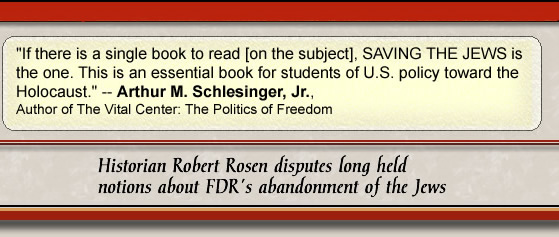


|
Reviews |
|
|
|
|
|
|
Why I Wrote The Book |
|
|
Excerpts |
|
|
Table Of Contents |
|
|
Auschwitz |
|
|
SS St. Louis |
|
|
Timeline |
|
|
A Survivor Speaks Out |
|
|
Carter Center Speech |
|
|
Justice At Nuremberg |
|
|
Purchase |
|
|
Related Links |
 This book was inspired by a visit to the Boston Holocaust Memorial near Quincy Market. My daughter, Ali, then a student at Phillips Academy, and I visited that Holocaust Memorial, and we read these words:
This book was inspired by a visit to the Boston Holocaust Memorial near Quincy Market. My daughter, Ali, then a student at Phillips Academy, and I visited that Holocaust Memorial, and we read these words:
“By late 1942, the United States and its Allies were aware of the death camps, but did nothing to destroy them.”
I told Ali that this statement could not possibly be true. The United States was not even a belligerent in World War II until December 7, 1941 when the Japanese bombed Pearl Harbor. How could we have saved the Jews of Europe in 1942?
But, “Dad,” she said, “I don’t think they put lies on Holocaust Memorials.” I told Ali I thought the statement – while literally true – was not correct, and I set out to find what this was all about. It turns out that the statement implies, incorrectly, that we Americans were morally culpable for failing to destroy death camps we were unable to destroy in 1942,or in 1943 for that matter.
What I found was quite remarkable: One of the biggest mistaken interpretations of American history ever, and it involved one of our most important presidents, Franklin Delano Roosevelt. A large group of historians, writers, journalists, filmmakers, activists, rabbis, and others, have created a body of work which paints FDR, his Administration and the American people as not caring at all about the plight of European Jewry, and even complicit in the Holocaust. In the words of one prominent historian, David Wyman, the Roosevelt Administration and the American people were, the “ all too passive accomplices,” of the Nazis.
Many of you are familiar with these books, The Abandonment of the Jews by Wyman, While Six Million Died by Arthur D. Morse - among many others, and with this version of history. Millions of Americans have been influenced by them because general American histories rely on these books and authors.
THE ONLY PROBLEM IS THAT IN MY OPINION - AFTER SIX YEARS OF RESEARCH - THEY ARE WRONG.
These are the main charges made against Franklin Roosevelt: His failure to save the passengers on the S.S. St. Louis in 1939, his failure to change the immigration laws and to speak out against the Holocaust; and his refusal to bomb Auschwitz.
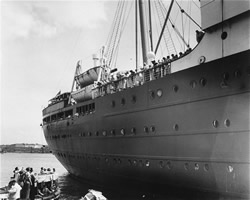 The critics say that Roosevelt refused to let Jewish refugees come to America. The voyage of the S.S. St. Louis, the “Voyage of the Damned,” is the chief incident trumpeted against him. Let the facts speak for themselves. The St. Louis sailed from Hamburg in May of 1939 before either World War II or The Final Solution had begun. It arrived in Cuba. The Jewish passengers had purchased visas which were illegal under Cuban law and the Cuban president would not honor them. The State Department and the American Jewish Joint Distribution Committee-known as the “Joint”- worked day and night to convince the Cubans to take in the passengers. The Joint sent a lawyer to Havana with a suitcase full of money to bribe the Cuban government. Henry Morganthau Jr., Roosevelt’s Jewish Secretary of the Treasury, the person in charge of the Coast Guard, was person ally involved. Sadly, all of their efforts failed. 29 of the 936 passengers got off in Cuba. Even though the Roosevelt Administration urged the Cuban government to allow the remaining 907 passengers to land, the S.S. St. Louis began its return to Europe.
The critics say that Roosevelt refused to let Jewish refugees come to America. The voyage of the S.S. St. Louis, the “Voyage of the Damned,” is the chief incident trumpeted against him. Let the facts speak for themselves. The St. Louis sailed from Hamburg in May of 1939 before either World War II or The Final Solution had begun. It arrived in Cuba. The Jewish passengers had purchased visas which were illegal under Cuban law and the Cuban president would not honor them. The State Department and the American Jewish Joint Distribution Committee-known as the “Joint”- worked day and night to convince the Cubans to take in the passengers. The Joint sent a lawyer to Havana with a suitcase full of money to bribe the Cuban government. Henry Morganthau Jr., Roosevelt’s Jewish Secretary of the Treasury, the person in charge of the Coast Guard, was person ally involved. Sadly, all of their efforts failed. 29 of the 936 passengers got off in Cuba. Even though the Roosevelt Administration urged the Cuban government to allow the remaining 907 passengers to land, the S.S. St. Louis began its return to Europe.
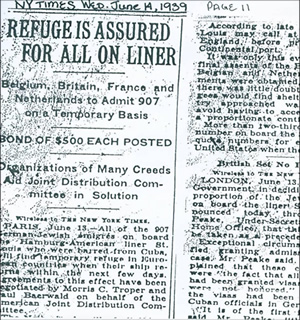 With the active intervention of the State Department and the “Joint”, the St. Louis went to England (not Germany), where 288 of the 907 passengers disembarked and survived the Holocaust. The remaining 619 disembarked at Antwerp and went to France, Belgium, and Holland. The leading authorities on the St. Louis estimate that 392 of the 619 who disembarked at Antwerp survived the war. Thus more than 2/3 of the passengers on the St. Louis survived the Holocaust.
With the active intervention of the State Department and the “Joint”, the St. Louis went to England (not Germany), where 288 of the 907 passengers disembarked and survived the Holocaust. The remaining 619 disembarked at Antwerp and went to France, Belgium, and Holland. The leading authorities on the St. Louis estimate that 392 of the 619 who disembarked at Antwerp survived the war. Thus more than 2/3 of the passengers on the St. Louis survived the Holocaust.
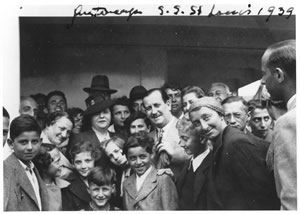 The passengers knew that Americans had saved them. “Our gratitude is as immense as the ocean on which we are now floating,” they wired Morris Troper of the Joint. Three years later, after Hitler conquered the Netherlands, France, and Belgium, and initiated the Final Solution, 227 of the St. Louis’s 936 passengers became victims of the Holocaust. Of course in June 1939 no one could have foreseen this. The death camps did not even exist in 1939. The Roosevelt Administration had done all it could.
The passengers knew that Americans had saved them. “Our gratitude is as immense as the ocean on which we are now floating,” they wired Morris Troper of the Joint. Three years later, after Hitler conquered the Netherlands, France, and Belgium, and initiated the Final Solution, 227 of the St. Louis’s 936 passengers became victims of the Holocaust. Of course in June 1939 no one could have foreseen this. The death camps did not even exist in 1939. The Roosevelt Administration had done all it could.
But why did we not allow the St. Louis passengers in? America had taken in millions of Jews, Poles, Italians, Greeks, Slavs, and others in the late 19 th and early 20 th century. The ancestors of most Jews in America today emigrated between 1880 and 1920. But by the 19 teens, the great majority of Americans feared the new wave of immigrants. By the 1920s, after the Haymarket bombing by anarchists in Chicago in 1886, the rise of violent, radical, and even revolutionary labor movements, the assassination of President McKinley in 1901 by a Polish anarchist, the Bolshevik Revolution of November, 1917, the rise of the Communist party in the United States, the dramatic increase in the number of Polish and Italian Catholics, Slavs, Jews and others whose politics, culture, religion, dress, language, and behavior were very foreign to the majority of white Anglo Saxon, Protestants, Americans demanded that Congress dramatic ally curtail immigration. Congress did so in draconian laws enacted in 1921 and 1924.
Antisemitism certainly played in this legislation, although only a part. Clearly Jewish radicals, such as Emma Goldman whose boyfriend, Alexander Berkman who shot Carnegie Steel executive, Henry Clay Frick, did not win any friends. And the large number of Jews who were active in left-wing Socialist, anarchist and Communist causes, did not endear the American people to Jewish immigrants.
“The Statue of Liberty would still stand in New York harbor,” Maldwyn Jones observed, “but the verses on its base would henceforth be but a tribute to a vanished ideal.” (40) The immigration laws were amended, by an overwhelming vote in the Senate of 62 to 6 and in the House of Representatives of 326 to 71. (40)
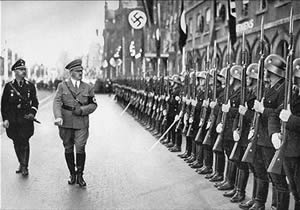 Thus, when Hitler came to power in 1933 and began persecuting the Jews, America was no longer an asylum for those seeking freedom. A strict quota system had been put in place in 1924, 15 years before the voyage of the St. Louis and 17 years before the “Final Solution” began. Every historian agrees that it was a political impossibility to change these laws.
Thus, when Hitler came to power in 1933 and began persecuting the Jews, America was no longer an asylum for those seeking freedom. A strict quota system had been put in place in 1924, 15 years before the voyage of the St. Louis and 17 years before the “Final Solution” began. Every historian agrees that it was a political impossibility to change these laws.
 We must also keep in mind that when Roosevelt came into office in 1933, the Great Depression overshadowed everything else. Tens of millions of Americans were unemployed. Life in the United States presented a dismal picture: “In the long-blighted countryside,” David M. Kennedy wrote, “unmarketable crops rotted in fields and unsalable livestock died on the hoof….in towns and cities across the country haggard men in shaggy overcoats, collars turned up against the chill wind, newspapers plugging the holes in their shoes, lined up glumly for handouts at soup kitchens.” (42)
We must also keep in mind that when Roosevelt came into office in 1933, the Great Depression overshadowed everything else. Tens of millions of Americans were unemployed. Life in the United States presented a dismal picture: “In the long-blighted countryside,” David M. Kennedy wrote, “unmarketable crops rotted in fields and unsalable livestock died on the hoof….in towns and cities across the country haggard men in shaggy overcoats, collars turned up against the chill wind, newspapers plugging the holes in their shoes, lined up glumly for handouts at soup kitchens.” (42)
There was no possibility of the United States opening its doors to any more immigrants, regardless of their religion, race, or tragic situation. The passengers on the St. Louis were among many European refugees---anti-Nazis, anti-Fascists, Socialists, labor leaders, refugees from the Spanish Civil War---all seeking entrance to the United States.
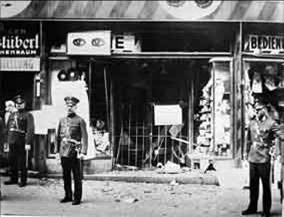 Despite all that, Franklin Roosevelt was outraged by the Nazis’ treatment of German Jews. He thought Hitler was insane. After the Crystal Night pogrom of November 1938, Roosevelt recalled the American ambassador to Germany. He was shocked by the actions of the Nazis. “I myself could scarcely believe that such things could occur in a twentieth century civilization,” he said at a press conference. No U.S. Ambassador returned to Germany until the Nazis were overthrown. And Roosevelt was the only important world leader to criticize Germany about Crystal Night. (76)
Despite all that, Franklin Roosevelt was outraged by the Nazis’ treatment of German Jews. He thought Hitler was insane. After the Crystal Night pogrom of November 1938, Roosevelt recalled the American ambassador to Germany. He was shocked by the actions of the Nazis. “I myself could scarcely believe that such things could occur in a twentieth century civilization,” he said at a press conference. No U.S. Ambassador returned to Germany until the Nazis were overthrown. And Roosevelt was the only important world leader to criticize Germany about Crystal Night. (76)
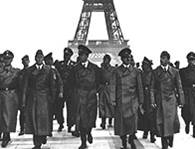 Contrary to popular belief, and in the face of strict immigration quotas, both the leadership of the American Jewish community and the Roosevelt Administration were actively involved in trying to save as many Jews as they reasonably could prior to the outbreak of World War II in September 1939 and the fall of France in June, 1940. 25% of all German Jews had fled from Germany between 1933 and 1937. In September 1939 the German Jewish population was 185,000 meaning 340,000 German Jews (65%) had fled prior to World War II. Of the 185,000 Jews in Austria in 1938, 126,000 had emigrated by 1940. (441) Between 1933 and 1942, 161,000 Jews came to the U.S. Between 1938-1940 half of all immigrants to the U.S. were Jews. [ I repeat, half of all immigrants…] The United States accepted about twice as many refugees as the rest of the world combined, 200,000 of 300,000. (442)
Contrary to popular belief, and in the face of strict immigration quotas, both the leadership of the American Jewish community and the Roosevelt Administration were actively involved in trying to save as many Jews as they reasonably could prior to the outbreak of World War II in September 1939 and the fall of France in June, 1940. 25% of all German Jews had fled from Germany between 1933 and 1937. In September 1939 the German Jewish population was 185,000 meaning 340,000 German Jews (65%) had fled prior to World War II. Of the 185,000 Jews in Austria in 1938, 126,000 had emigrated by 1940. (441) Between 1933 and 1942, 161,000 Jews came to the U.S. Between 1938-1940 half of all immigrants to the U.S. were Jews. [ I repeat, half of all immigrants…] The United States accepted about twice as many refugees as the rest of the world combined, 200,000 of 300,000. (442)
After the fall of France in 1940, the United States and Great Britain were stunned. France’s army had been larger than the German army. People could not believe that Germany could so swiftly conquer, not only France, but Norway, Denmark, Poland, the Netherlands, and Belgium.
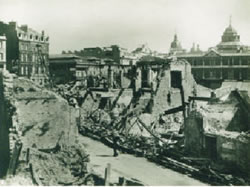 In this atmosphere, Roosevelt was not about to admit any European refugees to the United States given the nature of the threat, the adamant opposition of the American people and Congress, the possibility of terrorists bombing American military targets (which the Germans actually did during World War I), and the desperate need for consensus in the conduct of American foreign policy.
In this atmosphere, Roosevelt was not about to admit any European refugees to the United States given the nature of the threat, the adamant opposition of the American people and Congress, the possibility of terrorists bombing American military targets (which the Germans actually did during World War I), and the desperate need for consensus in the conduct of American foreign policy.
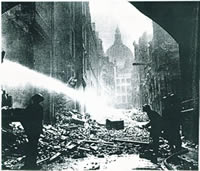 Meanwhile, Hitler’s chief victims, were the Jews of Poland and Russia, who could not be saved. Of the nearly six million Jews who were murdered in the Holocaust, 4,565,000 were Polish and Russian and 125,000 were German. We have to keep in mind that the German Army and the S.S. controlled all aspects of life in Europe and that Poland was a very long way from Great Britain. We barely saved Great Britain and the Soviet Union. The Jews of Europe could only be saved by the defeat of the massive German war machine.
Meanwhile, Hitler’s chief victims, were the Jews of Poland and Russia, who could not be saved. Of the nearly six million Jews who were murdered in the Holocaust, 4,565,000 were Polish and Russian and 125,000 were German. We have to keep in mind that the German Army and the S.S. controlled all aspects of life in Europe and that Poland was a very long way from Great Britain. We barely saved Great Britain and the Soviet Union. The Jews of Europe could only be saved by the defeat of the massive German war machine.
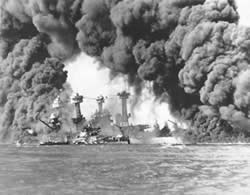 We must also remember that, after Pearl Harbor, our nation’s mission was the defeat of not one but two genocidal tyrannies, the Nazis and the Japanese militarists who had attacked us and killed over 2,000 Americans at Pearl Harbor. During World War II, the Japanese committed genocide on a massive scale.
We must also remember that, after Pearl Harbor, our nation’s mission was the defeat of not one but two genocidal tyrannies, the Nazis and the Japanese militarists who had attacked us and killed over 2,000 Americans at Pearl Harbor. During World War II, the Japanese committed genocide on a massive scale. 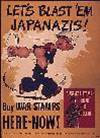 They murdered 20 million Asian civilians. (493) The United States was in a vicious war with the Japanese, whom the American people detested far more than the Germans. Roosevelt, however understood that the Germans must be defeated first.
They murdered 20 million Asian civilians. (493) The United States was in a vicious war with the Japanese, whom the American people detested far more than the Germans. Roosevelt, however understood that the Germans must be defeated first.
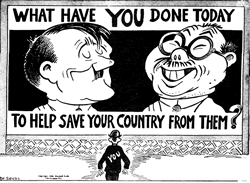
The Final Solution began with the German invasion of the Soviet Union in June 1941. Roosevelt had been re-elected by promising to keep a reluctant America out of the war. Massive massacres of Jews, such as the murder of 33,000 at Babi-Yar occurred in September 1941 before the United States was even in the war.
By the end of 1942, Hitler was the master of Europe, from Norway to North Africa, from the Atlantic Ocean to the gates of Moscow. He was able to annihilate six million Jews in Poland, the Soviet Union and Europe, as he had absolute control of the killing fields.
View Presidents Warning On Atrocities
Those who say that Roosevelt and the American people were silent about the Holocaust are wrong again. Roosevelt denounced the massacre of the Jews in the strongest possible terms beginning in August 1942. War criminals, he said, would face “fearful retribution.” The State Department made “the most vigorous representations possible,” to the French Vichy government, protesting the deportation of the Jews.
View US Rebukes Vichy On Deporting Jews
As early as October 7, 1942, Roosevelt warned the Nazi leaders that the Allies were aware of their war crimes and that “it was the intention of this government that the successful close of the war shall include provisions for the surrender to the United Nations of War Criminals; and that the criminals would receive a certain punishment.” This was the origin of the Nuremberg trials.
View Nazi Punishment Seen By Roosevelt
View President Predicts Murder Orgy by Nazis to Wipe Out Minorities
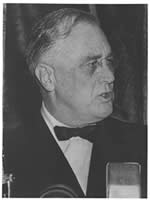 Rabbi Stephen Wise and other Jewish leaders meet with Roosevelt on December 8, 1942 to request that the president issue a declaration condemning the massacre of Jews specific ally. The United Nations Declaration on Jewish Massacres was issued on December 17, 1942, nine days after Rabbi Wise and his delegation requested it. Signed by the United States, Great Britain, the Soviet Union, and eight occupied countries, it denounced, “in the strongest possible terms, this bestial policy of cold-blooded extermination.”
Rabbi Stephen Wise and other Jewish leaders meet with Roosevelt on December 8, 1942 to request that the president issue a declaration condemning the massacre of Jews specific ally. The United Nations Declaration on Jewish Massacres was issued on December 17, 1942, nine days after Rabbi Wise and his delegation requested it. Signed by the United States, Great Britain, the Soviet Union, and eight occupied countries, it denounced, “in the strongest possible terms, this bestial policy of cold-blooded extermination.” 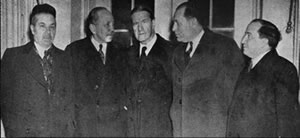 It condemned the German governments’ “intention to exterminate the Jewish people in Europe….” The Declaration received wide publicity in the American press. It was on the front page of the New York Times. In the eyes of the world, it committed the Allies to prosecute war crimes against the Jewish people. It simply would not have happened without FDR’s strong concern about the Jews of Europe.
It condemned the German governments’ “intention to exterminate the Jewish people in Europe….” The Declaration received wide publicity in the American press. It was on the front page of the New York Times. In the eyes of the world, it committed the Allies to prosecute war crimes against the Jewish people. It simply would not have happened without FDR’s strong concern about the Jews of Europe.
View 11 Allies Condemn Nazi War On Jews
Why this declaration is barely quoted by legions of Roosevelt critics I do not know. Michael Beschloss in his best seller, The Conquerors, entitles his chapter on the subject, “The Terrible Silence,” and claims there was a “conspiracy of silence.” But there was no conspiracy and Roosevelt was certainly not silent.
The Jews of Europe had been Hitler’s prisoners since 1940. 3.5 million Jews were dead by December 1942, one year after Pearl Harbor. Not until the Normandy invasion could we begin the process of liberating Hitler’s Jewish prisoners, held, beyond Germany, in faraway Poland.
 Until May 1943 we were losing the Battle of the Atlantic. We could not invade Western Europe, let alone rescue the Jews in Poland. Roosevelt’s critics do not seem to know that until May 1943 more American ships were sunk by German U-boats than succeeded in arriving in Great Britain.
Until May 1943 we were losing the Battle of the Atlantic. We could not invade Western Europe, let alone rescue the Jews in Poland. Roosevelt’s critics do not seem to know that until May 1943 more American ships were sunk by German U-boats than succeeded in arriving in Great Britain. 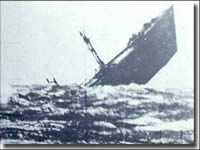 Thousands of merchant mariners died in the freezing waters of the North Atlantic. Churchill later admitted that the U-boat was “the only thing that really frightened me during the war.” “The Germans never came so near to disrupting communication between the New World and the Old World as in the first 20 days of March 1943,” the Admiralty Staff concluded. “From the Allied point of view,” historian Samuel Elliot Morison observed, “Victory was not even in sight.”
Thousands of merchant mariners died in the freezing waters of the North Atlantic. Churchill later admitted that the U-boat was “the only thing that really frightened me during the war.” “The Germans never came so near to disrupting communication between the New World and the Old World as in the first 20 days of March 1943,” the Admiralty Staff concluded. “From the Allied point of view,” historian Samuel Elliot Morison observed, “Victory was not even in sight.”
Even in the face of this difficult military situation, Henry Morganthau, Jr. and others, convinced FDR to establish an American agency to try to save the Jews of Europe, FDR created the War Refugee Board in 1944 by executive order. He warned the Hungarians in March 1944 to not participate in what he called, “one of the blackest crimes of all history, begun by the Nazis in the days of peace and multiplied by them a hundred times in time of war. The wholesale systematic murder of the Jews of Europe goes on unabated every hour.” He promised swift punishment to the Nazis. “The United Nations has made it clear,” he said, “that they will pursue the guilty and deliver them up in order that justice be done.”
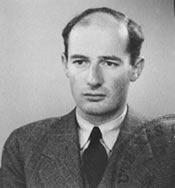 The accomplishments of the War Refugee Board are disputed by historians. But whatever it did accomplish (and some historians argue that it saved up to 200,000 Jews) was accomplished with funds from the American Jewish community, the Joint, and the Roosevelt Administration. For example, the savior of many Jews, Raoul Wallenberg, is revered by Roosevelt’s critics as, “a Swedish diplomat.” But, in fact, he was an agent of the War Refugee Board, the Roosevelt Administration and the Joint. He would never have gone to Hungary had it not been for the War Refugee Board, the Joint and the donations of American Jews.
The accomplishments of the War Refugee Board are disputed by historians. But whatever it did accomplish (and some historians argue that it saved up to 200,000 Jews) was accomplished with funds from the American Jewish community, the Joint, and the Roosevelt Administration. For example, the savior of many Jews, Raoul Wallenberg, is revered by Roosevelt’s critics as, “a Swedish diplomat.” But, in fact, he was an agent of the War Refugee Board, the Roosevelt Administration and the Joint. He would never have gone to Hungary had it not been for the War Refugee Board, the Joint and the donations of American Jews.
Finally we come to the explosive issue of the failure to bomb of Auschwitz. Arial View Of Auschwitz
We first have to accept the fact that the power and precision of World War II aerial bombardment was mythical and the American military knew it. Only one in five bombers got within 5 miles of its designated target. Successfully bombing Auschwitz meant killing the Jews in the camps. This included killing Anne Frank and her entire family. Bombing the railroad tracks from Hungry to Auschwitz would have been useless. First, it was a difficult task limiting air power needed for Normandy invasion in the Summer of 1944; second, trains could divert to other routes; and third, the railway lines could be repaired in a matter of hours. As Georgians are well aware, even the Confederate Army could quickly repair railway lines during the Civil War. That is why General William Tecumseh Sherman tied them in knots (474).
View Railroads and Auschwitz
There is no question that American bombers could have bombed Auschwitz between May and November 1944. Indeed the U.S. Air force bombed the complex where Auschwitz was situated. But no one wanted to bomb Auschwitz, especially Jews. The overwhelming majority of the Jewish leadership worldwide - including David Ben-Gurion (later the first Prime Minister of Israel), Jewish Agency Executive of Palestine, and the World Jewish Congress - adamantly opposed the bombing, “We do not know the truth concerning the entire situation in Poland,” Ben-Gurion said, “and it seems we will be unable to propose anything concerning this matter.” Another member of the JAE said, “it is forbidden for us to take responsibility for a bombing that could very well cause the death of even one Jew.”
A. Leon Kubowitzki, himself a refugee from Nazi-occupied Europe and head of the rescue department of the World Jewish Congress, wrote the director of the War Refugee Board, John Pehle, and underlined it for emphasis: “ View Letter The destruction of the death installations cannot be done by bombing from the air, as the first victims would be the Jews who are gathered in these camps, and such a bombing would be a welcome pretext for the Germans to assert that their Jewish victims have been massacred not by their killers, but by the allied bombings.”
Despite erroneous assertions by many historians and the United States Holocaust Memorial Museum, Jewish leaders overwhelmingly opposed the bombing of Auschwitz. Kubowitzki wrote to one Jewish leader, “I think you know that we are not in favor of the bombing of the extermination installations….Because we believe in hayei shaa [literally, “life of the hour,” meaning saving those currently living] and we are afraid for the Jewish victims of such bombings and giving the Germans an alibi.” View Letter
The Holocaust Museum takes one of Kubowitzki’s numerous letters to John McCloy, assistant Secretary of War and enlarged it to make it appear that he was requesting the bombing of Auschwitz. Not True. This letter, the centerpiece of the Museum’s display on the bombing of Auschwitz, merely passed on a message from the Czechoslovakian government in exile and McCloy was well aware that Kubowitzki and the World Jewish Congress adamantly opposed the bombing of Auschwitz. View First Letter View Second Letter (I have written the Holocaust Museum about this blatant error, but have yet to hear back from their Chief Historian.)
Representatives of all major Jewish organizations meet with Pehle, the Director of the War Refugee Board, on August 16, 1944 and none were in favor of the bombing of Auschwitz. It is a controversy created by historians, not by the actual participants in history.
What then can we say finally about |
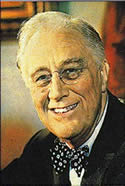 |
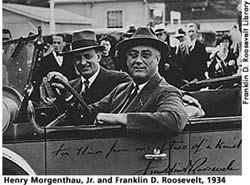 First FDR had the support of 90% of American Jews in his races for the Presidency. “The Jews have three velten [“worlds” in Yiddish], Congressman Jonah J. Goldstein quipped, “Die velt [this world], yene velt [the next world], and Roosevelt.” [xxi] In fact, there were so many Jews in high and mid-level positions in FDR’s administration that it was referred to by numerous antisemites as “the Jew Deal” not the “the New Deal.”
First FDR had the support of 90% of American Jews in his races for the Presidency. “The Jews have three velten [“worlds” in Yiddish], Congressman Jonah J. Goldstein quipped, “Die velt [this world], yene velt [the next world], and Roosevelt.” [xxi] In fact, there were so many Jews in high and mid-level positions in FDR’s administration that it was referred to by numerous antisemites as “the Jew Deal” not the “the New Deal.”
View FDR Cartoon
View Second FDR Cartoon
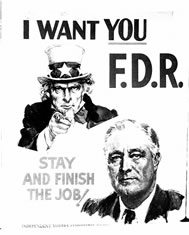 In February of 1945 after the Yalta conference, Roosevelt went to see Ibn Saud, the leader of Saudi Arabia to convince the Muslim leader to support a Jewish state in Palestine. He told Saud he felt “a personal responsibility” for the Jewish victims of the Holocaust who had suffered “indescribable horrors at the hands of the Nazis” (412-413). Although he failed to convince Ibn Saud, Roosevelt had no political reason to go see him. He had no more elections ahead of him. He did not need votes in New York. In fact he would be dead in 8 weeks. So much for the nonsense that FDR was an antisemite.
In February of 1945 after the Yalta conference, Roosevelt went to see Ibn Saud, the leader of Saudi Arabia to convince the Muslim leader to support a Jewish state in Palestine. He told Saud he felt “a personal responsibility” for the Jewish victims of the Holocaust who had suffered “indescribable horrors at the hands of the Nazis” (412-413). Although he failed to convince Ibn Saud, Roosevelt had no political reason to go see him. He had no more elections ahead of him. He did not need votes in New York. In fact he would be dead in 8 weeks. So much for the nonsense that FDR was an antisemite.
***
I will leave you with the views of two contemporary American rabbis on FDR’s death:
“Men the world over will ever be grateful to God,” Rabbi Max Kleiman said in his eulogy of Roosevelt, “that is was this man who stood at the helm in a position to give leadership to the American people in the dark hours of ruthless Nazi barbarism seeking to destroy the work of ages.” (89)
And Rabbi David Matt said:
“As to the Jews in Europe and the Jewish aspirations in Palestine, Roosevelt was a powerful and sympathetic friend and spokesman. His passion for justice and his innate, over-mastering desire to aid the underprivileged, those who were most in need of help, explain his great interest in the welfare of the Jews of the world, who were the first, and the greatest, sufferers from Nazism and Fascism."